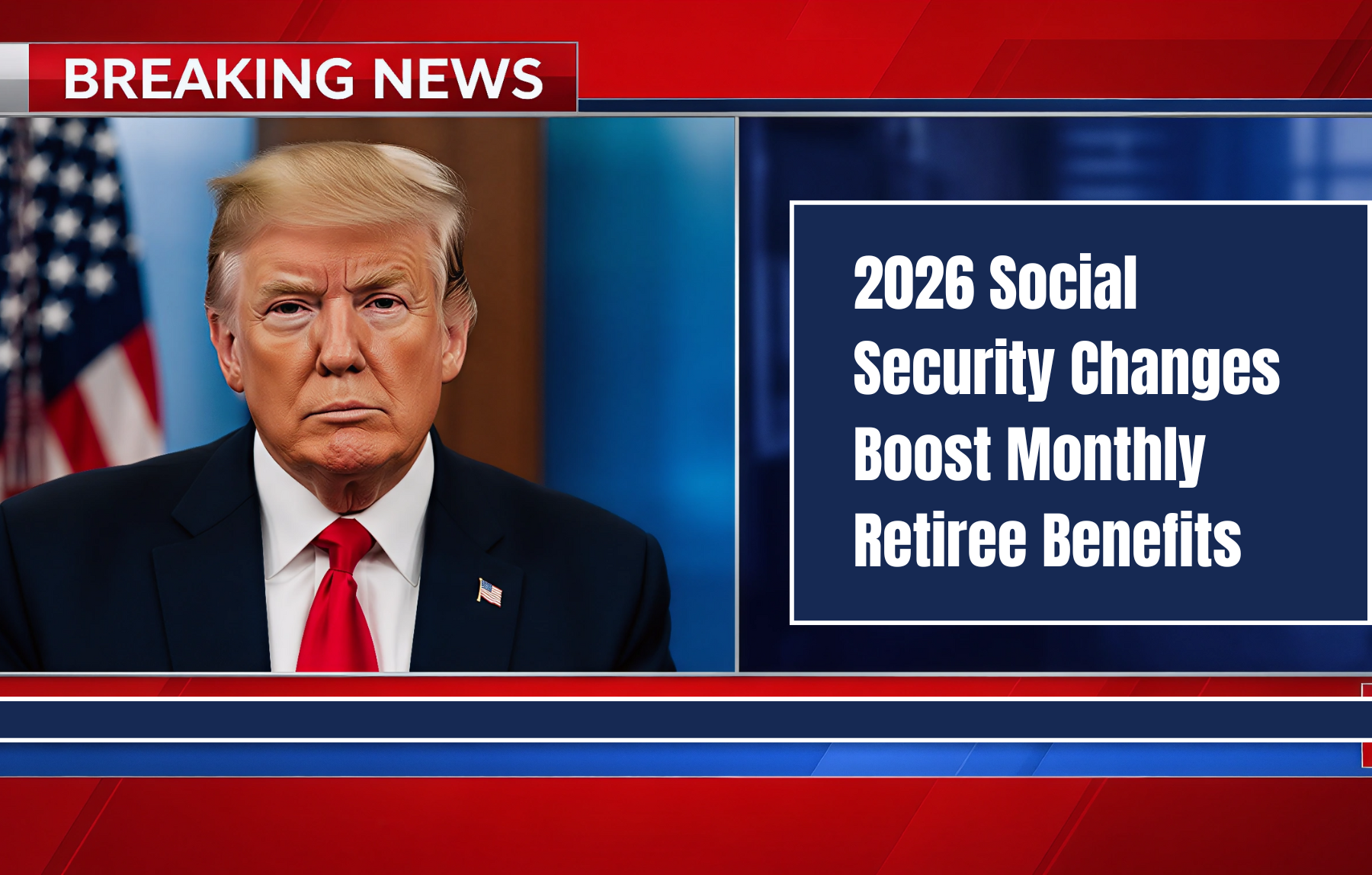What’s Driving “Overhaul” Talk?
There isn’t a single law yet called a “Social Security 2026 Overhaul,” but there are several changes coming in 2026 (and late 2025) that together significantly shift how much retirees receive, when they receive full benefits, and what parts of their benefits might be taxed or reduced. Key drivers include inflation (and thus Cost‑of‑Living Adjustments, or COLA), rising Medicare premiums, changes in retirement age definitions, repeal of certain provisions that reduced benefits for some retirees, and increases in taxable wage limits and earning caps for those working while receiving Social Security.
Major 2026 Changes: What’s Expected / What’s in Law

1. Cost‑of‑Living Adjustment (COLA) Increase
One of the biggest “good news” items for retirees in 2026 is a projected increase in benefits via COLA. Based on inflation trends, economists and nonprofit senior‑advocacy groups like The Senior Citizens League estimate a 2.7% to 2.8% COLA for 2026.
If that holds true:
- Average monthly retirement benefit (around US$2,008 as of mid‑2025) would grow by about $50‑$55/month (from ~$2,008 to ~$2,062) starting January 2026. That works out to roughly $600‑$650 extra per year for many.
- For those receiving larger benefit checks (e.g., those with maximum qualifying earnings over many years), the increase in dollars could be higher.
However, note that inflation projections could shift. If inflation spikes or falls, the final COLA announced in October 2025 could be somewhat higher or lower than the 2.7‑2.8% estimate.
2. Retirement Age Full (FRA) Moves to 67
The Full Retirement Age (FRA) — the age at which someone can collect 100% of their Social Security retirement benefit — is gradually increasing. For people born in 1960 or later, the FRA becomes 67 starting in 2026.
What this means:
- If you were born in 1960 or onward, you will need to wait until age 67 to receive your “full” benefit.
- If you claim earlier, at, say, 62, your monthly benefit will be permanently lower than if you wait until FRA. The reduction depends on how many months before FRA you claim.
- Those born in 1959 reach FRA at 66 years and 10 months starting November 2025.
This change has been legislated for many years (since the Social Security Amendments of 1983), so it’s not a surprise, but it’s worth noting for younger people who may be planning their retirement timeline.
3. Repeal of Windfall Elimination Provision (WEP) & Government Pension Offset (GPO)
One of the biggest benefit increases for certain retirees has already happened via the Social Security Fairness Act, signed into law earlier in 2025. It eliminates both WEP and GPO, which had reduced Social Security benefits for people who also receive a pension from work not covered by Social Security (common among public employees like teachers, police, firefighters).
Consequences:
- Over 3.2 million Social Security recipients who were affected by WEP or GPO will receive higher monthly payments starting in April 2025.
- They will also receive retroactive payments to make up for what they lost due to those provisions, backdated to January 2024 (when the law came into effect) in many cases.
- This change is separate from COLA increases — it’s a benefit increase due to law change.
4. Medicare Part B Premiums Will Rise

While benefits are going up, costs are rising too. One major offset to COLA gains comes from projected increases in Medicare Part B premiums.
- The projected Part B premium for 2026 is $206.20/month, up from about $185/month in 2025.
- Because most people who receive Social Security also are enrolled in Medicare, that increase often gets deducted from their benefit checks. That means part of the COLA bump may be eaten up by higher healthcare costs.
5. Increase in Taxable Wage Base (Payroll Taxes)
Another change impacts working individuals who pay into Social Security and whose earnings exceed a certain limit.
- The maximum taxable earnings base for Social Security (the amount of income subject to Social Security payroll tax) is set to increase to about $183,600 in 2026, up from ~$176,100 in 2025.
- That doesn’t directly increase benefits for everyone, but it does affect how much people contribute, and for high‑earners it affects what counts toward their “maximum earnings” years (which help determine higher benefit amounts for people who earned high wages over many years).
6. Changes to Earnings Test (If You Work While Receiving Benefits)
If you collect Social Security before your FRA but continue working, there’s an “earnings test” that can reduce your benefit for that year if your work income exceeds certain thresholds.
- In 2026, retirees under FRA will be able to earn more before reductions begin. The estimated annual earnings limit for those below FRA is ~$24,360. Every dollar earned above that reduces benefits $1 for every $2 earned above that cap.
- For those reaching FRA in 2026, the limit is higher (estimated ~$64,800), with a different reduction rate ($1 benefit withheld for every $3 earned above limit until month of FRA).
These changes give more flexibility to people who want to keep working while drawing benefits, though claiming early still means permanent reduction in base benefit.
Net Effect: What Retirees Might Actually Experience

Putting together all the above, here is what many retirees will likely see in 2026:
- A modest bump in monthly benefit checks due to COLA (≈ $50‑$55 extra for average retiree), plus possible larger boosts for those with higher benefits or decades of high earnings.
- If you’re affected by WEP or GPO, much larger increases could come, because those law changes undo prior reductions. Public employees with non‑SSA pensions will be among the biggest gainers.
But also:
- Higher Medicare costs will reduce net gain: Part B premium increases are likely to eat a large slice of COLA for many.
- Changes in FRA to 67 for people born in 1960 or later mean that if you were expecting full benefits at a younger age, those expectations must shift.
- Those working and receiving benefits may be able to earn more without losing benefits, which helps if you’re still employed part time.
What Retirees Should Do / Plan For
Because the changes are incremental and mixed (some positive, some cost offsets), retirees should consider taking these actions:
- Check Your Benefit Statements Now
Look at your Social Security “MySSA” account and yearly statements to understand your current benefit, what your FRA is, and how working now might affect those benefits. - Estimate COLA Impact
Using your current benefit, calculate what a 2.7‑2.8% increase would mean. Then subtract expected Medicare Part B premiums (or other deductions) to see net gain. - Review Work Plans
If you’re planning to work while receiving benefits, understand the earnings thresholds and how they will change in 2026 so that you don’t unexpectedly lose benefit amounts. - Plan Retirement Timing
If you are born in 1960 or later, your full benefit age is 67. Deciding to delay claiming benefits could result in higher monthly checks, but you also need to balance that with other sources of income or your health and lifestyle preferences. - Watch Taxes on Benefits
The change in deductions for some retirees (e.g. via The “one big, beautiful bill” — see below) may reduce federal taxation on Social Security benefits for many seniors, depending on their income. Knowing your adjusted gross income and whether you’ll qualify for deductions is important. - Budget for Increased Healthcare Costs
Because of rising premiums (Medicare Part B, etc.), some of your benefit increases will go toward these. Plan accordingly.
Important Laws and Proposals Already in Effect
- The Social Security Fairness Act has already repealed WEP & GPO, increasing benefits for affected public employees starting in April 2025, including retroactive payments. This law is already giving many retirees a real increase in their checks.
- The “one big, beautiful bill” provides a temporary increased standard deduction for many seniors (65+) that may reduce or eliminate federal taxation on Social Security benefits, depending on income levels. It is in effect (2025‑2028) and can affect what retirees net after taxes.
What to Expect: Good News, Mixed News, and What Might Surprise You
Good news:
- Retirees will see real increases in monthly benefits via COLA.
- Many public employees affected by previous reductions will get significant boosts due to the repeal of WEP/GPO.
- For people who continue working while collecting benefits, the thresholds are higher and more favorable.
Mixed/less good news:
- The higher Medicare Part B premiums will cut into those gains meaningfully. In many cases, it’s estimated that a large part (maybe ~40%) of the COLA increase could go simply to cover the premium hike.
- Raising the full retirement age (for new retirees) means that future retirees born in 1960 or later have to wait longer (or accept reduced benefit if claiming earlier).
Surprises to watch for:
- The exact value of COLA isn’t finalized until October 2025 (because Social Security uses CPI‑W data from July‑September). If inflation shifts dramatically in those months, the COLA could differ (higher or lower).
- Because of deductions (Medicare, possibly taxes, etc.), the “check you receive” may not rise as much as the headline COLA suggests.
Limitations & Risks
- Social Security trust fund projections show increasing financial pressure over time; there is ongoing policy debate about how to maintain solvency. That may lead to future changes (tax increases, benefit adjustments, retirement age changes).
- Inflation is unpredictable. If prices for essentials (healthcare, housing, groceries) rise faster than projected inflation indices, many retirees may still feel squeezed.
- Costs of living vary regionally. Even with a nationwide COLA, people in high cost‑areas may find the increase less helpful.
- Legislation can change. Some proposals are still under debate; not all “expected” changes are guaranteed.
Bottom Line
Putting all this together, “Social Security 2026” does increase monthly benefits for retirees, but how much more, for whom, and net of new costs depends greatly on personal factors like:
- When you were born (which affects your full retirement age)
- Whether you’re affected by the WEP or GPO repeal
- Your current benefit level
- Whether you’re enrolled in Medicare and what your Part B and other premiums will be
- Whether you are still working and will hit earnings thresholds
On average, retirees can expect about $50‑$55/month more thanks to COLA if inflation stays on predicted course, plus added gains if you had reduced benefits under WEP/GPO. But those gains won’t always feel huge once Medicare premiums and other deductions are subtracted.
FAQs
1. Is there a Social Security “Overhaul” happening in 2026?
Not officially, but several key changes—COLA increase, FRA shift, WEP/GPO repeal, and Medicare premium hikes—are combining to significantly impact retiree benefits in 2026.
2. How much is the expected Social Security COLA in 2026?
Estimates suggest a 2.7% to 2.8% COLA, which would raise average monthly benefits by about $50–$55, or roughly $600–$650 annually, depending on inflation.
3. When does the new Full Retirement Age (FRA) of 67 start?
Starting in 2026, people born in 1960 or later will have an FRA of 67 to receive full Social Security retirement benefits without a permanent reduction.
